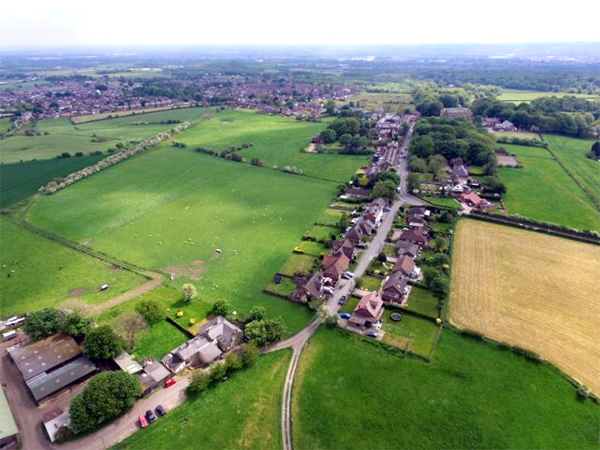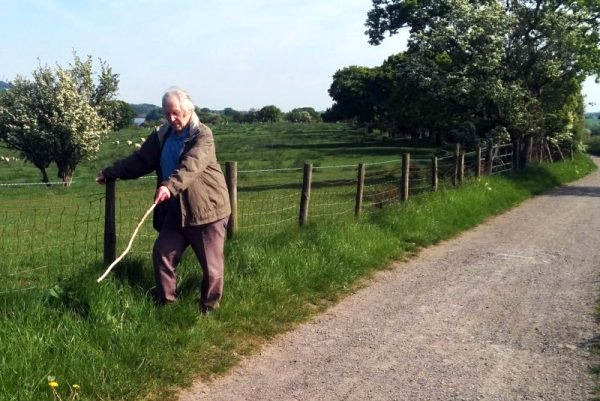
A Roman road from the fort at Wigan to the fort at Ribchester has long been speculated on. In 2017 a possible route out of Wigan through Haigh attracted our attention and we spent much of that summer excavating a site on Toddington Lane.
The result was however inconclusive and we were left with some loose ends to sort out. We had discovered the main road, built presumably by the Victorians, connecting Haigh with Blackrod, underlying what Mrs Pendlebury, the landowner, thought was a Roman milestone. About half a metre below that lay another hard surface but its origins couldn't be determined due to of the restricted access (i.e. the lane on one side and a high bank on the other). Further down the hill, the high bank levels out but our investigations here proved fruitless as any evidence of either feature had been trashed by landscaping in the 70's. However on the OS map of 1849, the width of the Victorian road is shown to extend beyond the current lane and into the field on the other side.
Here, therefore, is a chance for us to uncover more of the old road and perhaps the earlier road surface. In this area on the OS map there is also shown a well which disappears on later maps (wells were generally abandoned in the late 19th century when mains water became widely available). It would be interesting to see if anything remains of this well and what curiosities people may have deposited in it. Excavations are planned for this month, so, if you want to get involved, let me know asap (more details on our website here.)

Last month I finally got Jack Smith to show me exactly where on Healey Nab he, and Chorley Arch Soc, had excavated in the 1960's. The dig (as reported in Newsletter No.209) took place somewhere along Heapey Fold Lane which runs along the east flank of the Nab. The lane is roughly on the right alignment for the road from Wigan to Ribchester; however the Chorley Soc were more interested at the time in its alignment with a farm called The Street which is located on the western edge of the Upper Rivington Reservoir. They were speculating on the possibility of a secondary Roman road running between Blackrod and Heapey which is to the north of Chorley (it is here where a hoard of Silver and coins was found in the 19th century). The cobbled surface they discovered had curbing stones and Jack remembers the site being near to a tenon-top gate post. When Jack finally settled on the location, there was no evidence on the ground. However further south on the lane, cobbling could be seen, perhaps providing some evidence for the ancient road. A chat with the lady living at the cottage just to the south of the lane, gave us some reassurance that some fieldwork could be a possibility at that location, so hopefully we will be able to arrange something in the near future. You can see more details of our trip here.
Summer Trip
Nothing has been arranged for this yet but there has been a suggestion of a visit to Astley Hall in Chorley together with a trip to see the excavations of a medieval metal working site on Holcombe Moor. Any other suggests and dates would be most welcome - something to discuss at our next meeting.
Next Meeting
Wednesday 5th June - at our new venue The Bellingham (7.30pm as usual). This month Steve Baldwin from Bluestone Archaeology will be telling us all about his exciting new Fort in the Wood project. In last month's newsletter I described how the discovery of this brand new Roman fort had been announced at the CBA conference and how we had confirmed it by our extensive resistivity survey last summer. Now a season of excavations is planned for July and Steve is looking for volunteers. He will be running a summer School which will include formal training for those new to archaeology leading to a 'Skills Passport'. Details of the project together with how to book a place can be found on the website here.
Steve and his team have been excavating the site, on and off, for a number of years now and have turned up some fascinating finds and features. These include hearths, stone structures (possibly a granary) and cobbled surfaces but most significantly organic material which can provide a reasonably accurate date using Carbon 14 dating. However this process is expensive and Steve is finding ways to fund the cost including crowd funding and applying for a grant. He'll be able to explain more at the meeting - hope to see you there, BA.
|



